It’s a few weeks into 2018, I know, but!
Bear with me. I’ve been scrambling a bit these past few weeks and haven’t done much substantial reading, SO for my first ~official~ post I decided to do reviews of the books I loved in 2017. Hopefully this will also give you an idea of what I like to read, and give you an idea of what you’ll see on this blog. Let’s get right into it! These books are: Do Not Say We Have Nothing by Madeleine Thein; The Fifth Season by N.K. Jemisin; Grace of Kings by Ken Liu; Monstress, written by Marjorie Liu and drawn by Sana Takeda; and Oryx and Crake by Margaret Atwood. Enjoy!
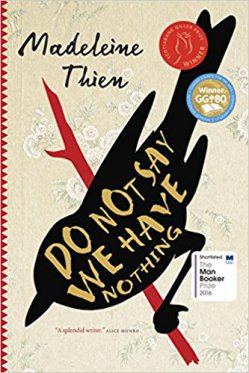
The short of it: A profoundly sad and beautiful tale about family secrets and hardship that spans three generations, beginning in modern-day Vancouver and stretching back to China in the 1940s. Check it out if you like your fiction with a bit of history; you are ready to cry over some of the most well-written characters you’ve read; have a high tolerance for tragedy; and enjoy classical music.
The long of it:
“If you’re trapped in a room, and nobody is coming to save you, what can you do? You have to bang on the walls and break down the windows. You have to climb out and save yourself. It’s obvious, Li-ling, that crying doesn’t help a person live.”
This book broke my heart. Thein masterfully weaves an intricate plot that bounces back and forth through time, beginning in modern-day Vancouver with a girl named Jiang Li-ling, whose life is disrupted when her mothers brings in a Chinese refugee fleeing the aftermath of Tiananmen Square. Ai-Ming, the refugee, and Li-ling slowly discover their family histories are closely intertwined. There are four subsequent sections, though they are not presented in order, that cover distinct parts of Chinese history, from the 1940s land reforms to the Tiananmen Square protests. You will meet many characters, such as a trio of young musicians who have the great misfortune of being classical musicians in a time when everything classic must be destroyed. All characters are beautifully written, and perhaps the most touching representations of humanity I have read in a long while.
In this book you will encounter brutality; family mysteries; breathtaking acts of courage, large and small; and music that provides hope in the face of despair. The scale of history and tragedy is immense. If you do not know much about modern Chinese history, do not let that stop you. Thein masterfully presents the best piece of fiction I have read that deals with the horrific waste and loss of Mao Zedong’s regime.
This book broke my heart, and for this reason I recommend it to you. It’s been about a year since I read Do Not Say We Have Nothing, but its verse, so much like music, has stayed with me. The characters linger. Damn Thein for writing something that left me with more emotions than I could handle, but bless her for bringing these characters into the world.
The Fifth Season (Broken Earth #1) by N.K. Jemisin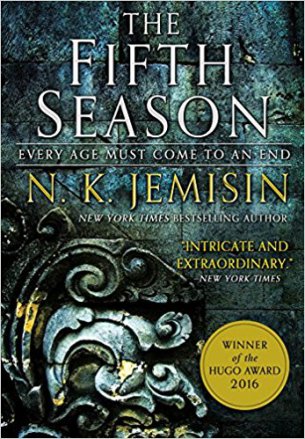
The short of it: THIS BOOK Y’ALL. The Fifth Season takes place in a world with only one continent, which is called the Stillness. This is ironic, because the destiny of the Stillness is to violently and catastrophically fall apart. The fifth season is essentially the apocalypse – it happens somewhat regularly in the Stillness, caused by earthquakes or famines or a volcanic eruption. The Fifth Season focuses on Essun, who is in shock after her husband murdered one of her children and kidnapped the other. The novel begins with Essun trying to find her remaining child, but as a new cataclysmic Season dawns, Essun’s journey becomes something new. Check it out if you love surprises; glossaries of new terminology; magic intertwined with science; and diverse characters you’ve wanted to see in fantasy for forever (I’m talking trans women, queer characters, characters of color);
The long of it:
The Fifth Season has been on my radar since I read Jemisin’s The Hundred Thousand Kingdoms (which I also recommend). And then Jemisin went and won two Hugos in. A. row. First for The Fifth Season, and then again for its sequel The Obelisk Gate. Here’s to hoping she goes three for three and wins yet another Hugo for the series’ final installment, The Stone Sky. Then my library finally got the entire series in and OH MY GOD. This novel (much like Grace of Kings below) beautifully reworks everything I’ve gotten tired of in fantasy, like fantastic Diverse Characters with a capital D and C. But I’m getting ahead of myself.
The Fifth Season takes place in a world with one supercontinent called the Stillness. However, the Stillness is anything but still. Every so often, the Stillness undergoes a massive catastrophe that nearly destroys humanity: floods, earthquakes, tsunamis triggered by earthquakes, volcanic eruptions, famine. These Seasons, as the periodic disasters are called, are well recorded. Humans have learned, more or less, how to recognize the signs of a Season and prepare for a dismal several decades. The constant threat of upheaval means that society is…less than pleasant. People are born into ‘use-castes’ and are assigned jobs based on their lineage. The most fortunate live in well established ‘comms’ that have proved their mettle by weathering multiple Seasons. Outcasts, or ‘commless’, are forced to wander alone and will likely die miserably. And God forbid you are an orogene, or have an orogene child.
That brings me to Essun. The book begins with Essun grieving the loss of her son, who was murdered by her husband on the suspicion of being an orogene. An orogene is someone with an innate ability to manipulate energy, especially the earth and temperature. Orogenes are hated, seen as inhuman, because they are dangerous. Most discover they are orogenes when, as a child, they become very angry and accidentally kill someone by leaching heat from their body or triggering a small earthquake. Most are murdered, like Essun’s son. Essun begins a journey to find her daughter, and while The Fifth Season may initially appear like a cut and dry hero’s quest, it quickly becomes anything but.
The Fifth Season kept me guessing, and without getting into spoiler territory, it was incredibly satisfying to see all of the hints Jemisin leaves about Essun, orogenes, and the Season pull together at the end. I cannot wait to pick up The Obelisk Gate, and based on what I’ve read, Jemisin deserves that third Hugo.
Grace of Kings (Dandelion Dynasty #1) by Ken Liu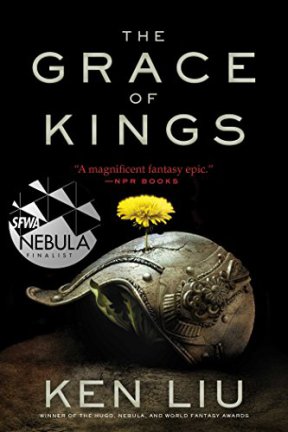
The short of it: A refreshing fantasy novel about a collapsing empire and the two men who seem destined to clash over who will build a new kingdom from the ashes. Check it out if you want a fantasy world that is not based on Europe; love good world building; are interested in military strategy (hell I’m not, but I loved it here); and are prepared for slack-jawed moments of how-did-they-pull-that-off awe.
The long of it:
Are you sick and tired of the same old fantasy tropes? Are you ready for a world that does not read like medieval-Europe-but-with-magic-and-dragons? Ken Liu delivers in Grace of Kings, a much-needed breath of fresh air in a fantasy market which can seem saturated by faux-Europe worlds populated by stoic white men with way too many apostrophes in their names. Grace of Kings takes inspiration from ancient China, with a political structure reminiscent of the Han dynasty, but does not fall into the faux-China trap. Instead, Liu has created the kingdom of Dara, an entirely new world that pays homage to the tradition of Chinese governance and culture without becoming reductive. Grace of Kings, the first book in the Dandelion Dynasty, focuses on the collapse of an empire and the battle to fill the power void. Emperor Mapidéré united the disparate kingdoms of Dara for the first time in history, but after two decades of rule Dara is rushing headlong into disintegration. Mapidéré is dying, the gods are scheming against him, and his massive infrastructure projects relied on enslaving the nation’s poor, all combining to create an atmosphere ripe for revolution.
Through twists of fate, two men become positioned to inherit Dara. One is Kuni Garu, a loveable ruffian with a quick tongue and even quicker wits who prefers drinking with his friends over holding down a job. The other is Mata Zyndu, a descendent of a military family ruined by Mapidéré, whose 8-foot-tall frame and double-pupiled eyes create rumors that the gods themselves chose him to rule Dara.
The book can be slow in the beginning, but once you understand the details, it soars. Never have I been so interested in the minutiae of royal succession and tax laws as I have been in the fantastic tug of war between two impressive characters. Everything I found so tiring about the fantasy genre is renewed in Grace of Kings – there is no Good and Evil, there is constant invention and scientific progress, and the women. Oh, the women. While the women in Grace of Kings are constrained by their gender, Liu does not use this as an excuse to brutalize and humiliate them (like in oh…Game of Thrones). They are painfully aware of their limitations, but forge ahead to support their own interests in any way they can. Admittedly, I finished Grace of Kings wanting more from the women, whose presence behind the scenes shaped the fate of Dara. I wanted them to be acknowledged damn it, I wanted more women in power, more women supporting each other, more everything. Then I read the second book, Wall of Storms, and women seize the fucking day.
Grace of Kings, and its sequel Wall of Storms, have earned a permanent spot on my favorite books list. They are vibrant, wonderfully crafted books, which fill my desire for a damn good story and remind me of the possibilities of fantasy.
Monstress Vol. 1 & 2: written by Marjorie Liu, illustrated by Sana Takeda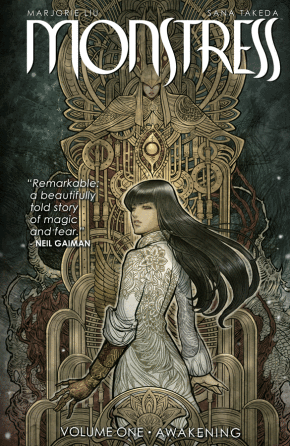
The short of it: Monstress takes place in what Liu calls a “matriarchal Asia” (DO YOU LOVE IT ALREADY) during a bloody conflict between humans and Archanics – magical beings who are losing the war. Badly. Maika Halfwolf, half-human and half-Archanic, discovers she has a dark power slowly awakening in her and embarks on a quest to learn more about her mysterious dead mother. Check it out if you could look at art deco work all day; have a taste for complex plots; and love cats (cats are knowledge keepers and professors y’all).
The long of it:
One of my good friends recommended Monstress to me, and I repeatedly thank her for bringing this amazing graphic novel into my life. In 2017 I swore to read more graphic novels, and while that goal fell through, Monstress is one I am so glad I was able to read. (Keep an eye out for more graphic novel reviews in 2018)
Monstress takes place, as noted about, in a “matriarchal Asia” during the 1900s. True to its dark tone, the novel opens with the main character, Maika Halfwolf, about to be sold during a slave auction. Maika is an Arcanic – magical beings with a wide variety of animal appearances, from sharks to foxes, and some look more human than others. Since Maika is half human, she passes for human almost entirely. There is a tepid agreement between humans and Arcanics that as long as they stay in their respective lands, they will not fight. Maika, having crossed into human territory, was captured. However, just because there is a tenuous stalemate does not mean Maika will be treated well. She is sold to the Cumea, a group of warrior-sorceresses who have immense political, economic, and military power. The Cumea murder Arcanics, even children, to harness magic to fuel their own spells and inventions. Little do the Cumea know, Maika discovered a dark, twisted, terrifying power has awoken within her, and she cannot control it. Since discovering this power, Maika began a journey to find out how her mother died in the hope this will reveal what awakened inside her.
Monstress is a complicated piece that deals with racism, colonization, social inequality, dehumanization, war, and power. This is not an easy read, and to this I credit Liu’s writing and Takeda’s gorgeous illustrations. Liu’s writing has depth – the plot and lore is complicated, and the graphic novel is more slowly paced than others I have read. This gives it time to unwind, explore the characters, and I can tell the plot has many layers. Takeda’s illustrations are flat-out beautiful, inspired simultaneously by art deco and manga. Her style is particularly good at capturing the evilness of society – Kippa is a great example. Kippa is a young Arcanic, who has a fox tail and ears but otherwise looks human. Kippa’s big, manga inspired eyes and expressions are startling when put into the violent context of the novel.
I read Monstress through Hoopla, but this is a graphic novel that merits a hard copy. A cautionary note is that Monstress does cover some topics that may be triggering, and I’m happy to give more specifics if needed! I can’t recommend Monstress enough – it digs into pertinent issues and doesn’t shy away from tackling difficult themes. Volume 1: Awakening and Volume 2: The Blood are out now, and Issue #13 will come out at the end of this month.
Oryx and Crake (MaddAddam #1) by Margaret Atwood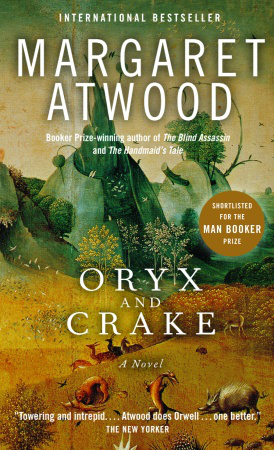
The short of it: Margaret Atwood wows, and warns, again in Oryx and Crake. Taking place after a plague wiped out humanity, Snowman believes he is the last ‘real’ human on Earth – there are also the Crakers, peaceful and innocent genetically engineered humanoids. Through Snowman’s tall tales to the Crakers, and his memories, find out how the world ended and what Oryx, Crake, and Snowman himself had to do with it. Check it out if you like speculative fiction; literary critiques of capitalism and corporations; satire; are wary of genetic engineering but can’t quite put your finger on it; and have time to read the whole trilogy because you can’t just read the one.
The long of it:
Yeah, yeah, 2017 was the year of Margaret Atwood and I am way behind the curve by writing about her right now. And yes, Oryx and Crake came out in 2003, but due to being small I wasn’t able to read it. So it took 14 years for me to finally enter the world of MaddAdam. And hoo boy if you haven’t read this trilogy, trust me, it’s well worth it even after a 14-year wait.
The entire MaddAdam trilogy takes place in a post-apocalyptic future after a pandemic devastated humanity. Oryx and Crake is narrated by Snowman, who may be the last human on Earth. Well, except for the Children of Crake, also called Crakers. The Crakers, though, were built and designed in a lab, eat exclusively leaves and grass, breed in seasons, know nothing of pain and fear, and do not understand anything of the world that came before them. They are fascinated by Snowman, because Snowman knew Crake – their creator. Back when Snowman was called Jimmy, or Snowman-the-Jimmy as the Crakers call him, he and Crake were good friends. Through Snowman’s stories to the Crakers and his own thoughts, we slowly learn how the world came to an end, who Oryx and Crake were, and who Snowman once was.
Like much of Atwood’s work, Oryx and Crake can feel like a warning, even more so than the Handmaid’s Tale. Many of the themes in the book, the pitfalls that led to the fall of society, are eerily similar to the inequalities and controversies we have today. Oryx and Crake covers the risks and arrogance of genetic modification – look out for pigoons, a genetically modified pig originally developed for quicker production of meat that becomes feral in the post-plague world. It covers economic/class inequality and capitalism gone amuck – in the pre-plague world people lived in compounds according to their company. The wealthier the company, the cushier the compound. Those unlucky enough to be poor, uneducated, and marginalized live in the Pleeblands, the dangerous and disease-riddled lands between compounds. It covers the commercialization of sex; rampant consumerism; the danger of prioritizing masculine traits over feminine.
I could go on and on – really, I wish I had read this in college so I could write a paper on it. I won’t bore you with more of my own thoughts, but please read it and come back so we can talk about it together. I need this conversation y’all. While you’re at it, take a gander at Year of the Flood (MaddAddam #2) and MaddAddam (MaddAddam#3). This series is like fine wine, just getting better with age. Plus, the second and third books have female narrators, which provides for an excellent avenue for Atwood to sharpen her social commentary. Just read it already, so we can speculate about how capitalism and corporations will destroy the world together.

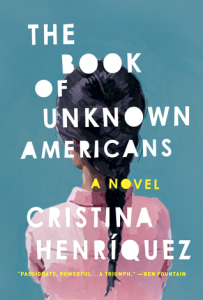

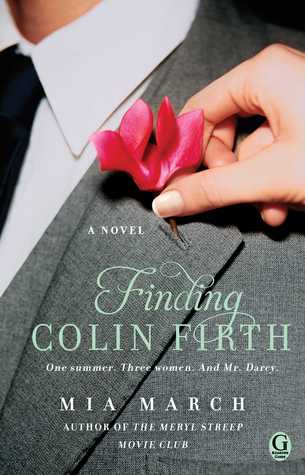

![Kiss My Boots: Coming Home Book 2 by [Sloan, Harper]](/ai/126/491/126491.jpg)